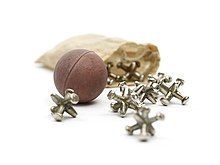
Back الجاكس Arabic Siklot BCL Ашик Bulgarian Pempigoù Breton Ossets (joc) Catalan Astragaloi German Resaltaĵo Esperanto Matatena Spanish Tortolosak Basque قاپبازی Persian


Knucklebones, also known as scatter jacks, snobs, astragaloi (singular: astragalus), tali, dibs, fivestones, jacks, jackstones, or jinks, among many other names,[1] is a game of dexterity played with a number of small objects that are thrown up, caught, and manipulated in various manners. It is ancient in origin and is found in various cultures worldwide.
The name "knucklebones" is derived from the Ancient Greek version of the game, which uses the astragalus (a bone in the ankle, or hock) of a sheep.[2] However, different variants of the game from various cultures use other objects, including stones, seashells, seeds, and cubes.[3]
Modern knucklebones consist of six points, or knobs, projecting from a common base and are usually made of metal or plastic. The winner is the first player to successfully complete a prescribed series of throws, which, though similar, differ widely in detail. The simplest throw consists in either tossing up one stone, the jack, or bouncing a ball and picking up one or more stones or knucklebones from the table while the ball is in the air. This continues until all five stones or knucklebones have been picked up. Another throw consists of tossing up first one stone, then two, then three, and so on and catching them on the back of the hand. Different throws have received distinctive names, such as "riding the elephant", "peas in the pod", horses in the stable",[4] and "frogs in the well".
- ^ "jackstones". Vocabulary.com. Retrieved 16 November 2020.
- ^ FN David. Games, Gods and Gambling: A history of probability and statistical ideas. London: Charles Griffin & Co., 1962. rpt New York; Dover, 1998. p 2.
- ^ Craig, Steve (2002). Sports and Games of the Ancients. Greenwood Publishing Group. pp. 110–113. ISBN 9780313316005.
- ^ Cite error: The named reference
EB1911was invoked but never defined (see the help page).